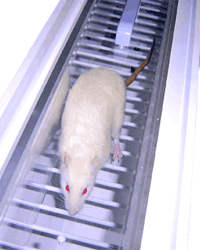
The Contextual Kits for T2CT have been designed to enhance thermal place preference studies...

The Contextual Kits for T2CT have been designed to enhance thermal place preference studies...
Discover our products
An easy way to objectively quantify the muscular strength of mice and rats, and to assess the...
Discover our products
The BIOSEB Spontaneous Activity Wheel offers an effective solution for quantifying rodent...
Discover our products
The BIOSEB Spontaneous Activity Wheel is an easy way to quantify rodent voluntary activity in...
Discover our products
The uncomplicated way to monitor rodent activity over several days from their home cage...
Discover our products
These small animal treadmills are used for forced exercise training and accurate testing of...
Discover our products
For testing animal's thermal sensitivity to pain resulting from exposure to heat or cold: the...
Discover our products
An operator independent test to study pain thresholds in rodents (mouse and rat) by assessing...
Discover our products
New and improved! The operator-independent Thermal Gradient Test used to show favorite...
Discover our products
The Contextual Kits for T2CT have been designed to enhance thermal place preference studies...
Discover our products
The advanced version of our Dynamic Weight Bearing Test for rodents (rats and mice) allows for...
Discover our products
An easy and non pain-inducing solution for assessing the level of discomfort (incapacitance) in...
Discover our products
A unique device that provides automated measurement of weight bearing and force distribution...
Discover our products![Dynamic Weight Bearing 2.0 – Postural Module [Add-on]](https://bioseb.com/733-home_default/dynamic-weight-bearing-20-add-on-postural-module.jpg)
Expand Your Analysis with Advanced Postural and Locomotor Calculations BIOSEB’s renowned...
Discover our products
A quick solution to determine the mechanical sensitivity threshold in rodents (mice and rats)....
Discover our products
As an electronic version of the classical Von Frey Filaments esthesiometer (or aesthesiometer),...
Discover our products
New ROBUST and modular cages to gently hold rodents (rats or mice) during nociceptive and...
Discover our products
An economical and versatile solution for when flexible quantitative sensory testing (QST) is...
Discover our products
Dedicated to small animals, like mice and rats, Smalgo is a pressure-based analgesimeter...
Discover our products
Bioseb's version 5 of the Tail Suspension Test system, based on both strain sensors and video...
Discover our products
NEW ! A complete (hardware + software), dedicated and automated solution for the Elevated Plus...
Discover our products
A unique setup for the automation of the Open Field test for rats and mice : 3D-camera based...
Discover our products
Open-field test - ARENA ONLY - used to evaluate of animal's basal activity and its evolution for...
Discover our products
The new Forced Swimming Test system from Bioseb uses a dual approach: Combining a double input...
Discover our products
A brand new innovative setup for the automation of the Novel Object Recognition Test : 3D-camera...
Discover our products
Open-field test - ARENA ONLY - used to evaluate of animal's basal activity and its evolution for...
Discover our products
An entirely modular experimental enclosure designed to conduct operant conditioning procedures...
Discover our products
A standard experimental chamber for automated or manual assessment of conditioned place...
Discover our products
Real-Time Physiological Monitoring for Small Animals – Wireless & Non-Invasive The Bioseb...
Discover our products
The ETH-401 is a bridge amplifier for various transducers that provides four channels of...
Discover our products
The IX-118 is a fast 100 Khz, high-resolution data acquisition system suitable for most data...
Discover our products
The ETH-256 is a 2 channels high performance, general-purpose life science research amplifier,...
Discover our products
Full-featured multi-channel stimulator for neuromuscular stimulation
Discover our products
Discover BIO-FOODIS, the next generation solution for understanding animal feeding behavior with...
Discover our products
The OXYLET system - Physiocage is a modular system allowing the integration of respiratory...
Discover our products
Innovative and appropriate equipment for measuring food/liquid consumption and correlated motor...
Discover our products
An economical, high performance Oxygen and Carbon Dioxide Analyzer with sampling rates fast...
Discover our productsA unique, automatic apparatus for the detailed and objective modeling of walking and coordination disorders in mice and/or rats, with respect to motor and psychomotor skills and cognition. An innovative and operator-independent solution for studies on myopathy, ataxia, alcoholism, Parkinson's and Huntington's disease, and much more.
![]()
![]()
![]() Presentation
Presentation

The Foot Misplacement Apparatus (FMA) is a unique system to objectively detect gait or walking disorders, abnormalities of coordination and motor or reflex problems in rodents (rat or mouse) in a highly accurate way, by recording the number, position and duration of errors of an animal walking in an opaque corridor on an horizontal ladder towards a dark compartment.
The ladder rungs can be removed to increase the difficulty of the exercise or create traps, and two sets of 77 infrared sensors are placed above and below the ladder to detect the subject’s movement and any paw misplacements.
The instrument allows you to quantify the recovery of sensorimotor activity, and is of particular interest for studies on myopathy, ataxia, alcoholism, Parkinson’s and Huntington’s disease, recovery from brain or spinal cord injuries, and much more !![]() Operating principle
Operating principle
A departure and an arrival box are located at opposite ends of a horizontal ladder encased in a corridor. Infra-red beams and sensors (-77 sets above and below the ladder) detect the subject’s movement along the length of the ladder and are used to recognize and record the exact position and duration of errors in motor coordination (missteps or paw slips between any 2 rungs). The included software differentiates among front and hind paw errors and erroneous tail errors.
The space between the rungs can be adjusted to increase the difficulty, and one or more rungs can be removed to create traps and assess cerebellar learning.
Data sheet
Number of publications:
An easy way to objectively quantify the muscular strength of mice and rats, and to assess the effect of drugs, toxins,...
The BIOSEB Spontaneous Activity Wheel offers an effective solution for...
The BIOSEB Spontaneous Activity Wheel is an easy way to quantify rodent voluntary activity in their home cage environment....
check_circle
check_circle